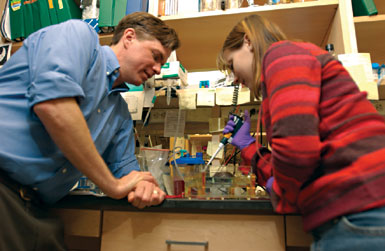Vital Signs
Research IDs new role for retinoids in slowing tumors
Retinoids, DMS researchers are finding, have the potential to treat a wider variety of cancers than had been thought. A recent study showed that removal of a protein called RIP140 greatly enhances the anti-cancer capabilities of retinoids—compounds derived from vitamin A.
Target: Working in a lab setting, the researchers treated testicular cancer cells with retinoids, which work through a process known as retinoic acid signaling. They bind to retinoid receptors, specific proteins in a cell's nucleus, and turn them on. The receptors then regulate the transcription of a panel of target genes. Earlier DMS studies had shown that a product of one of these genes is RIP140.

|
|
Kristina White, right, and Mike Spinella have been
investigating the anticancer capabilities of retinoids. |
RIP140 is responsible for repressing the retinoid receptors, adversely affecting their ability to differentiate cancer cells—in other words, make them mature into normal cells. "It's an unusual instance when the drug, retinoic acid, induces its own repressor," says Kristina White, lead author of the paper reporting the results and a graduate student in pharmacology and toxicology. The paper was published in the Journal of Biological Chemistry.
What White and her colleagues discovered is that if RIP140 was inhibited, and then the cancer cells were treated with retinoic acid (RA, a major active retinoid), the RA was much more effective in causing differentiation and slowing cancer growth.
RA: "One of the findings was that if you inhibit RIP140 by using a technique that degrades the message of RIP140, . . . and you treat with RA, all the other target genes are expressed much faster and to higher levels," explains the lab's principal investigator, Michael Spinella, Ph.D. "Kristina looked for differentiation, and she found out that cancer cells differentiated [in] two days with RA if she first removed the RIP140." With RIP140 present, it takes five days to see any change in cancer cells.
"As far as we can see," says White, "there's no other compensatory repressors. . . . It's pretty obvious that when you remove this protein [RIP140], nothing else is taking its place." Retinoids exist naturally in the diet in cheese, fish-liver oils, and dark green vegetables. For medical use, drug companies modify natural retinoids so they're less toxic and more effective in treating cancer.
RA has long been known to have anticancer properties; it is FDA-approved for treating acute promyelocytic leukemia and a few very rare cancers, and it's being studied for the treatment of lung and breast cancer. White, Spinella, and others are studying how retinoids and RIP140 affect two forms of breast cancer—hormone-dependent and non-hormone-dependent.
For example, RIP140 may play an important role in treating a kind of breast cancer that needs estrogen to grow. "RA can treat hormone-dependent cancers, and RA induces this repressor called RIP140," explains White. "And other research has shown that RIP140 can inhibit the estrogen-receptor pathway. Our theory is that RA induces RIP140, [which] switches to the estrogen-receptor pathway and is able to shut it down. However," she adds, "RIP140's role in breast cancer is more complicated, because it has the ability to block retinoids' action as well as the estrogen pathway."
Much work lies ahead to see how RA and RIP140 affect more complex models of cancer. The DMS researchers are hoping to ultimately use their findings to develop better differentiationbased strategies against cancer. "We're trying to see how widely [RIP140] applies to other tumors and other types of cancer and eventually to start testing it on animal models," says Spinella.
Matthew C. Wiencke
